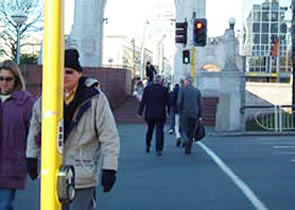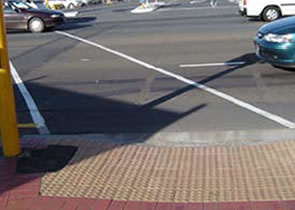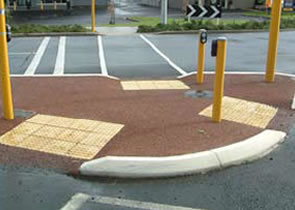
Pedestrians are the most vulnerable road users and require special consideration during signal design. People who walk may be too young or too old to drive or cycle, or have a vision impairment. Turning motorists may have to filter through parallel pedestrian movements and, due to the complex demands at signalised intersections, pedestrians may be unintentionally overlooked.
The following safety and efficiency issues can arise:

Figure 15 Bad practice of providing a crosswalk to the right of the side street at a T intersection without pedestrian protection

Figure 16 A late start of the vehicle phase provides pedestrian protection at this T intersection
The correct push button location is an important aspect for pedestrians, especially for those with vision impairment (many of whom also have a hearing impairment). The correct placement is at the cutdown associated to the crosswalk, with an embossed arrow indicating the direction of travel through the intersection. The use of audio-tactile equipment requires that push buttons for different crossings are not located too close to one another.
The following safety and efficiency issues can arise from poor push button locations:

Figure 17 Visually impaired pedestrians are directed away from the crosswalk by the warning paver layout. Tactile pavers should be laid at the same angle as the crosswalk.

Figure 18 Use of stub post for appropriate placement of pedestrian call box adjacent to the pram crossing. Note, however, that the stub post on the far side of the island is placed on the wrong side of the crosswalk.